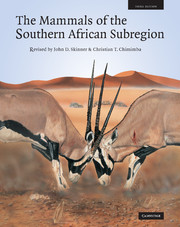Book contents
- Frontmatter
- Contents
- Editorial board
- Acknowledgements
- Foreword
- Preface
- The Mammal Research Institute
- R. H. N. Smithers
- Explanatory notes
- SUPERCOHORT AFROTHERIA
- COHORT PAENUNGULATA
- SUPERCOHORT EUARCHONTAGLIRES COHORT GLIRES
- Order LAGOMORPHA
- Order RODENTIA
- Suborder HYSTRICOGNATHI
- COHORT EUARCHONTA
- SUPERCOHORT LAURASIATHERIA
- COHORT FERUNGULATA
- Bibliography
- Appendix 1 Conservation status of southern African mammals
- Appendix 2 Colloquial names
- Index of scientific names
- Index of English colloquial names
- List of subscribers
- Plate Section
- Plate Section
- Plate Section
- Plate Section
- Plate Section
- Plate Section
- Plate Section
Order RODENTIA
from SUPERCOHORT EUARCHONTAGLIRES COHORT GLIRES
Published online by Cambridge University Press: 05 July 2013
- Frontmatter
- Contents
- Editorial board
- Acknowledgements
- Foreword
- Preface
- The Mammal Research Institute
- R. H. N. Smithers
- Explanatory notes
- SUPERCOHORT AFROTHERIA
- COHORT PAENUNGULATA
- SUPERCOHORT EUARCHONTAGLIRES COHORT GLIRES
- Order LAGOMORPHA
- Order RODENTIA
- Suborder HYSTRICOGNATHI
- COHORT EUARCHONTA
- SUPERCOHORT LAURASIATHERIA
- COHORT FERUNGULATA
- Bibliography
- Appendix 1 Conservation status of southern African mammals
- Appendix 2 Colloquial names
- Index of scientific names
- Index of English colloquial names
- List of subscribers
- Plate Section
- Plate Section
- Plate Section
- Plate Section
- Plate Section
- Plate Section
- Plate Section
Summary
THE NAME OF the order is derived from the Latin verb rodere, to gnaw. There is no absolute agreement among authorities on the classification of rodents, especially above the family level. Tullberg (1899) split the order into two tribes, Hystricognathi and Sciurognathi; Miller & Gidley (1918) into five superfamilies, Sciuroidae, Muroidae, Dipodoidae, Bathyergoidae and Hystricoidae; Ellerman (1940) into the Hystricomorphi and Sciurognathi; Simpson (1945) into three suborders, Sciuromorpha, Myomorpha and Hystricomorpha; and Roberts (1951) into five suborders, Hystricomorpha, Sciuromorpha, Dipodomorpha, Bathyergomorpha and Myomorpha. Anderson (1967), De Graaff (1981), Smithers (1983), Meester et al. (1986), and Skinner & Smithers (1990) essentially followed the subordinal classification of Simpson (1945), which relies on differences in skull morphology, mainly the zygomatic arch, and the origin and insertion of different components of the masseter muscle, as the taxonomic basis for subdividing the Order Rodentia.
In rodent skulls there is a foramen in front of the eye orbit known as the infra–orbital foramen or, better, the antorbital foramen because of its position in relation to the eye orbit. In many rodents this foramen, through which nerve and blood vessels pass, is small. In other species, however, it is greatly enlarged and, in addition to nerves and blood vessels, portions of the masseter muscle also pass through it.
- Type
- Chapter
- Information
- The Mammals of the Southern African Sub-region , pp. 77 - 78Publisher: Cambridge University PressPrint publication year: 2005
- 7
- Cited by

